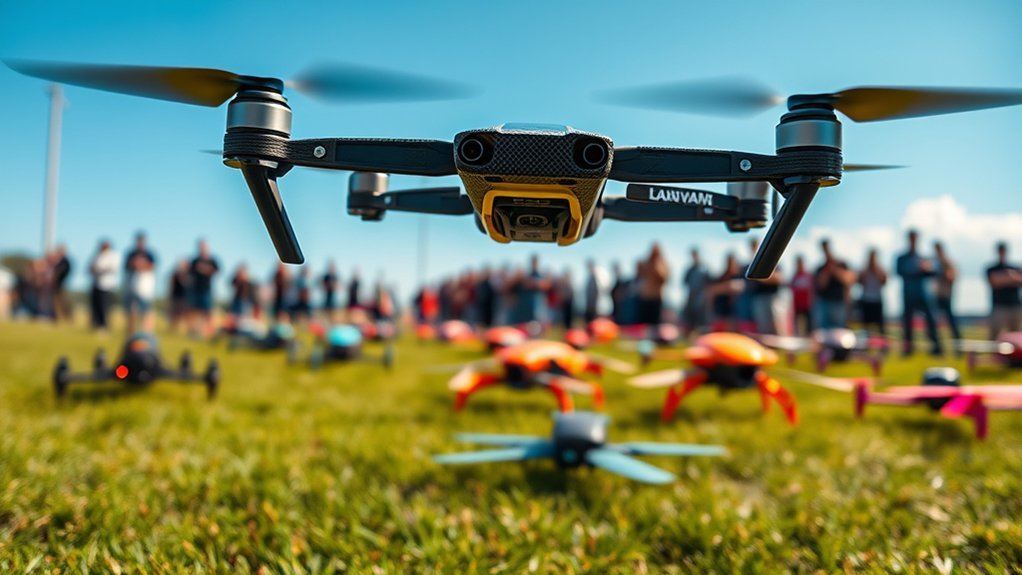As you gear up for the thrilling world of drone racing in 2025, it’s vital to know which models stand out for their speed and precision. With advancements in technology, you’ll find a range of options tailored for both beginners and seasoned pilots. From agile whoop quadcopters to robust racing kits, the choices are extensive. Let’s explore what makes these drones indispensable for your racing ambitions and how they can elevate your performance on the track.
BETAFPV ELRS Air75 Brushless Whoop Quadcopter
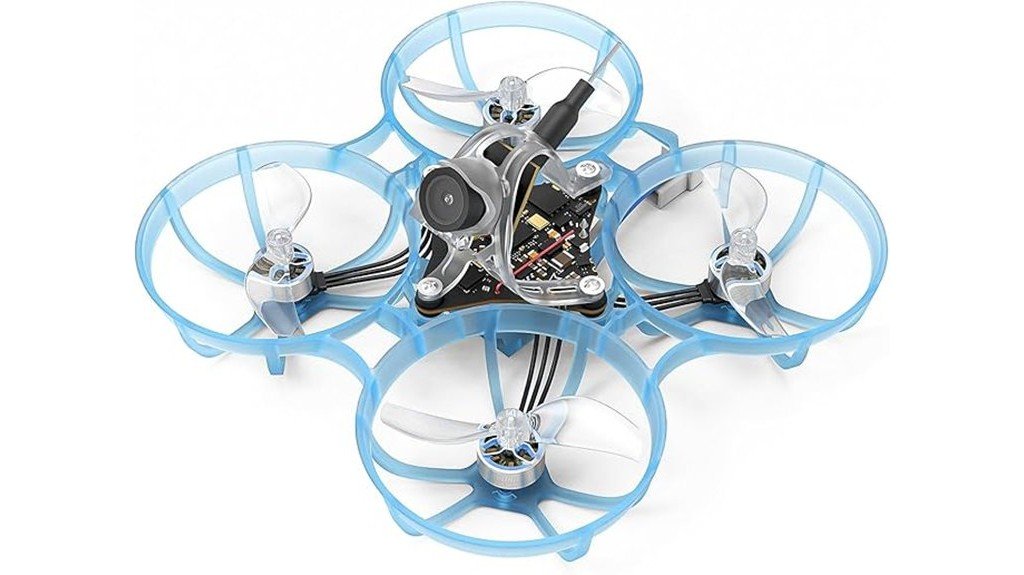
If you’re an advanced pilot looking for a lightweight and agile racing drone, the BETAFPV ELRS Air75 Brushless Whoop Quadcopter is your ideal choice. Weighing just 21g, this 75mm micro whoop drone offers unmatched speed and responsiveness with its 0802SE 23000KV motors and Gemfan 40mm props. The durable design features a redesigned air canopy that enhances impact resistance, ensuring your drone withstands tough races. With a 720p video capture and ExpressLRS control technology, you’ll enjoy seamless performance. Plus, its compact size makes it perfect for indoor and outdoor racing. Elevate your racing experience with this exceptional quadcopter!
Best For: Advanced pilots seeking a lightweight and agile racing drone with high FPV capability.
Pros:
- Exceptional speed and responsiveness due to 0802SE 23000KV motors and Gemfan 40mm props.
- Durable design with a redesigned air canopy that enhances impact resistance.
- Compact size suitable for both indoor and outdoor racing environments.
Cons:
- May not be ideal for beginners due to its advanced features and performance.
- Requires specific firmware (V3) for proper RX compatibility, which may necessitate re-binding.
- Limited video capture resolution at 720p compared to higher-end models.
Drone Obstacle Course with 3 Pack Easy to Build Hoop
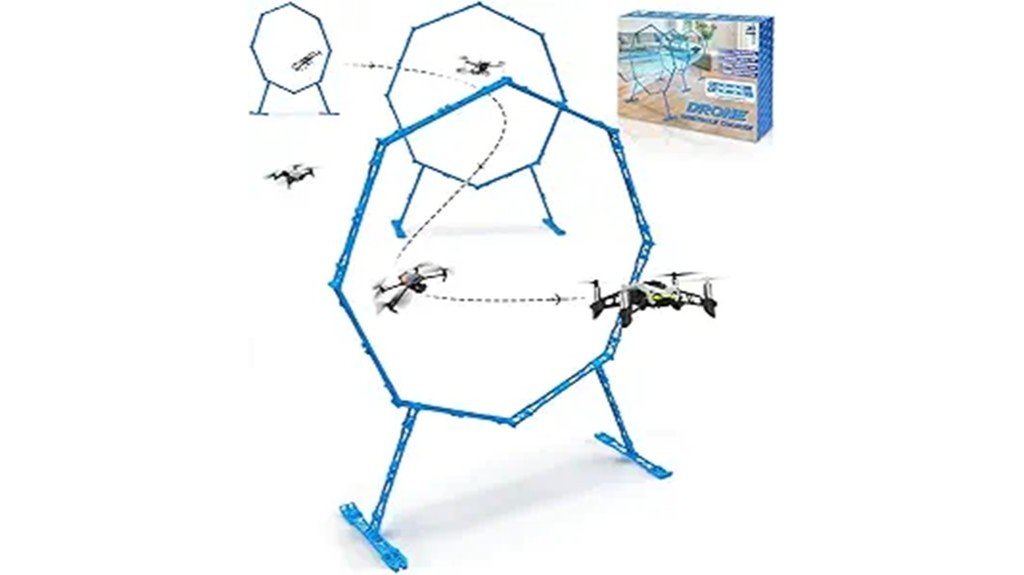
For FPV racing enthusiasts of all ages, the Drone Obstacle Course with 3 Pack Easy to Build Hoop is the perfect choice to elevate your flying skills. This course includes three durable hoops designed for obstacle avoidance training, making it ideal for both kids and adults. Its easy setup guide guarantees you can start racing in no time, whether you’re a beginner or a pro. Plus, you can configure three-loop routes for added challenge. Lightweight and portable, it’s perfect for outdoor adventures or friendly competitions. Enjoy hours of excitement while honing your skills in various locations.
Best For: FPV racing enthusiasts aged 6-12 and adults looking to enhance their flying skills.
Pros:
- Durable construction ensures long-lasting use even during intense racing.
- Easy setup with a step-by-step guide allows for quick assembly for beginners and pros alike.
- Portable design makes it convenient to transport and set up in various locations for outdoor racing.
Cons:
- May require a flat surface for optimal setup and performance.
- Limited to three hoops, which might not provide enough variety for advanced racers.
- Requires a compatible drone, which may not be included with the course.
APEX FPV Drone Kit for Beginners
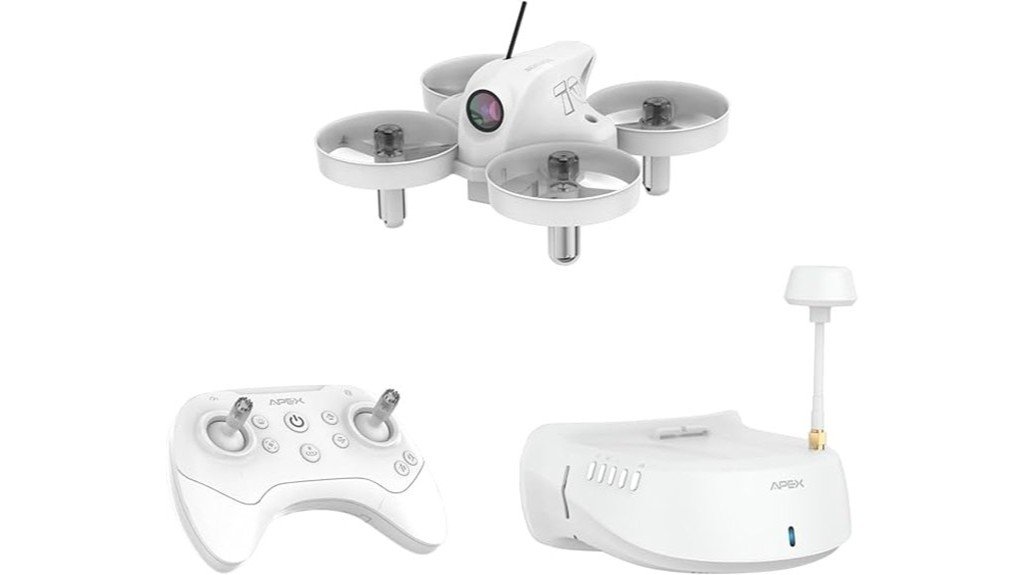
The APEX FPV Drone Kit is perfect for beginners keen to plunge into the world of FPV racing. This brushed drone, weighing just 100 grams, features low-latency 5.8G transmission and a drop-resistant design. You’ll enjoy an immersive flight experience with FPV goggles and a 120° view. The manual flying mode allows for freestyle control, while the altitude mode stabilizes the drone for easy handling. With three Lithium-ion batteries, you can fly for 15-18 minutes. Compatible with simulators, this kit also offers a 30-day return guarantee, making it a fantastic choice to kickstart your FPV racing journey!
Best For: Beginners looking to explore the exciting world of FPV racing with a user-friendly and durable drone.
Pros:
- Immersive Experience: The included FPV goggles provide a thrilling 120° field of view for real-time flying.
- Easy to Control: Altitude Mode stabilizes the drone, making it ideal for novice pilots.
- Multiple Batteries: Comes with three rechargeable Lithium-ion batteries, offering extended flight time of 15-18 minutes.
Cons:
- Limited Video Quality: The video capture resolution is only 480p, which may not meet the expectations of advanced users.
- Basic Features: As a beginner’s kit, it may lack advanced features for more experienced pilots.
- Weight: At 100 grams, it may be less durable in crashes compared to heavier models.
Drones for Kids 8-12 Mini Small Drone Indoor Toys
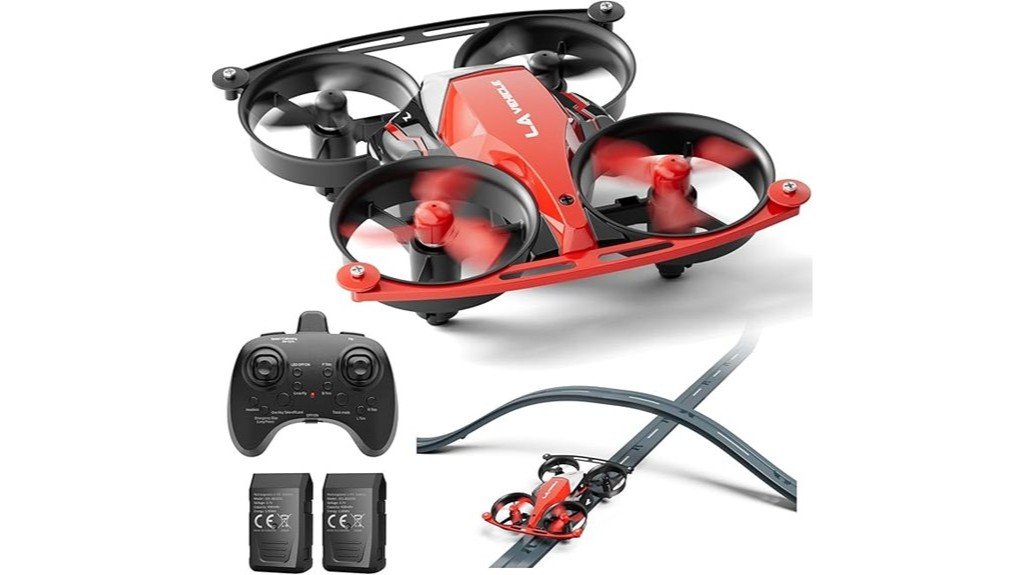
Packed with exciting features, the Drones for Kids 8-12 Mini Small Drone Indoor Toys by SPINORBITOR is perfect for young racing enthusiasts keen to explore the skies and the ground. This 2-in-1 RC quadcopter and car includes 24 track pieces for custom courses, smart bounce mode for dodging, and can perform 360° flips. Weighing just 39.5 grams, it’s easy to handle with kid-friendly controls. Safety features guarantee fun without worry, while its durable build withstands minor crashes. With two batteries providing 18+ minutes of flight time, your kids will enjoy endless adventures indoors or in open spaces.
Best For: Kids aged 8 and up who are interested in a versatile indoor drone and racing car experience.
Pros:
- Dual-Mode Functionality: Acts as both a quadcopter and a racing car, providing varied play options.
- Safety Features: Includes propeller protectors and a durable design to minimize injury and withstand minor crashes.
- User-Friendly Controls: Equipped with easy controls like one key takeoff/landing and altitude hold, making it suitable for beginners.
Cons:
- Build Quality Concerns: Some users have reported issues with the durability and performance after multiple uses.
- Hovering Difficulty: A few users have noted challenges in maintaining stable flight, particularly for beginners.
- Recommended Supervision: Adult supervision is advised for first-time flyers, which may limit independent play.
Tinyhawk 3 Freestyle PLUS+ RTF Kit Analog FPV Drone
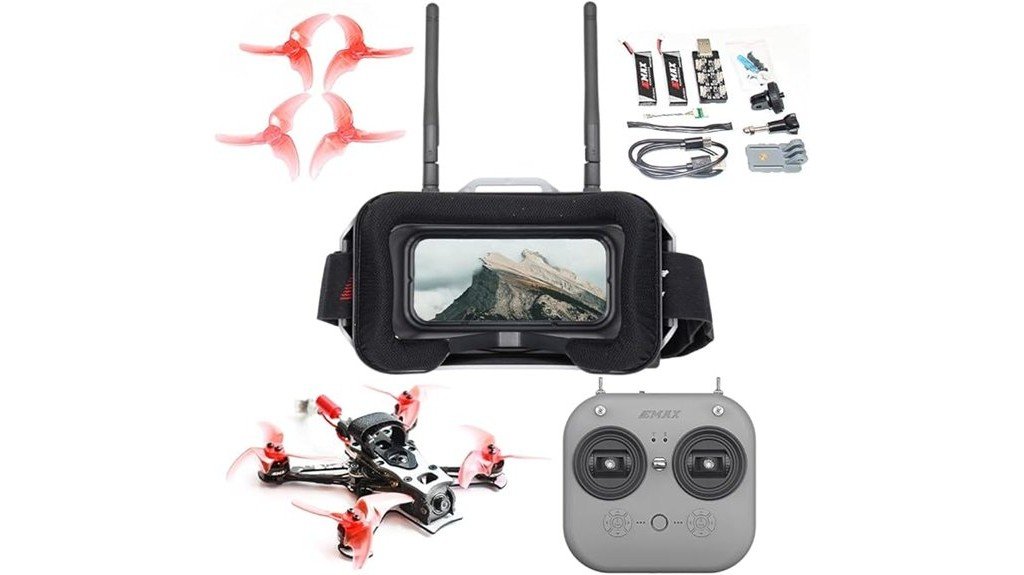
If you’re a racing enthusiast looking to elevate your flying experience, the Tinyhawk 3 Freestyle PLUS+ RTF Kit Analog FPV Drone could be your ideal choice. Weighing just 3.05 pounds and featuring a durable carbon fiber frame, it’s built for stability and performance. The included 450 mAh batteries guarantee longer flight times, while the enhanced signal strength lets you fly confidently in challenging environments. With its 2.5-inch propellers and user-friendly design, it’s perfect for beginners. You’ll appreciate the seamless integration with the provided controller and FPV goggles, making every race an exhilarating adventure. Get ready to soar!
Best For: Racing enthusiasts and beginners looking for a stable and user-friendly FPV drone experience.
Pros:
- Durable carbon fiber frame enhances stability and performance.
- Enhanced signal strength allows for confident flying in challenging environments.
- User-friendly design with included controller and FPV goggles for seamless integration.
Cons:
- Weighs 3.05 pounds, which may be heavier compared to some other FPV drones.
- Analog system may not provide the same video quality as digital systems.
- Limited flight time depending on battery capacity and usage.
Holy Stone HS440 Foldable FPV Drone with 1080P WiFi Camera
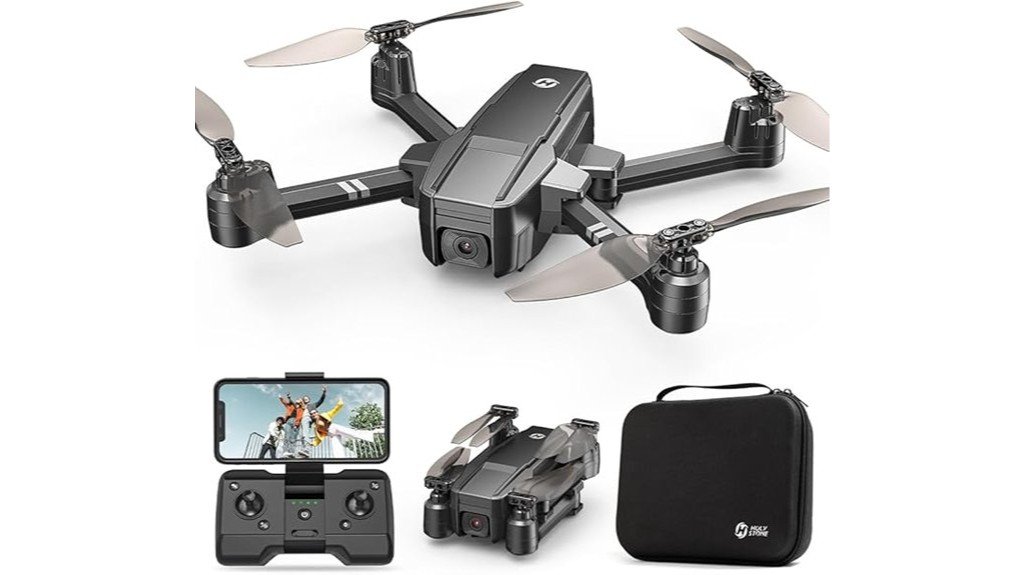
Elevate your aerial adventures with the Holy Stone HS440 Foldable FPV Drone, designed specifically for beginners and kids. This drone features a 1080P HD camera that adjusts up to 90° for stunning aerial shots, while its 112° wide-angle lens captures beautiful scenery at family events. Enjoy up to 20 minutes of flight time with a powerful battery, and experience effortless flying with automatic takeoff and precise hovering. Its foldable design and included carrying case make it easy to transport. With intelligent functions like Emergency Stop and one-key high-speed rotation, you’ll have a blast exploring and capturing your world.
Best For: The Holy Stone HS440 Foldable FPV Drone is best for beginners and kids looking to explore aerial photography and videography.
Pros:
- 1080P HD camera with a wide-angle lens for capturing stunning aerial images.
- User-friendly features like Automatic Takeoff and Emergency Stop enhance safety and ease of use.
- Foldable design and carrying case make it convenient for transport and outdoor adventures.
Cons:
- Flight range may be limited compared to more advanced drones.
- Battery life of 20 minutes might not be sufficient for longer shooting sessions.
- Some advanced features may be lacking for experienced drone pilots.
BETAFPV Meteor75 Pro 1S Brushless Drone
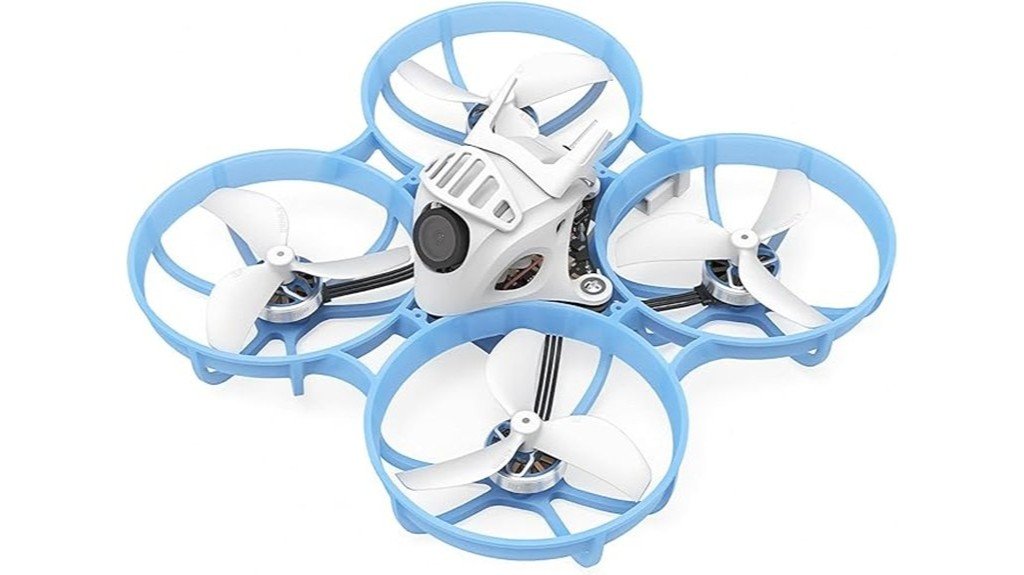
The BETAFPV Meteor75 Pro 1S Brushless Drone stands out as a top choice for racing enthusiasts seeking speed and agility in a compact package. This ultra-powerful 1S whoop quadcopter boasts a flight time of up to 6.5 minutes, driven by a BT2.0 550mAh Lipo battery. With its upgraded Matrix 5IN1 flight controller and 22000KV 1102 motors, you’ll experience remarkable responsiveness, perfect for FPV racing and acrobatics. The lightweight 1.45g FPV camera guarantees peak indoor performance, while the durable frame and 45mm propellers enhance precision flying. Get ready to release your racing skills with this impressive drone!
Best For: Racing enthusiasts and hobbyists seeking a compact, agile drone for FPV racing and acrobatic flying.
Pros:
- Ultra-powerful performance with 22000KV motors and a flight time of up to 6.5 minutes.
- Upgraded Matrix 5IN1 flight controller enhances responsiveness and computing speed for better flight control.
- Lightweight and durable design with an ultralight FPV camera and a sturdy frame for precise flying.
Cons:
- Limited flight time of only up to 6.5 minutes may require multiple batteries for extended sessions.
- Indoor-focused camera may not perform as well in outdoor scenarios with varying lighting conditions.
- Compatibility with only specific 45mm propellers may limit customization options for some users.
Sky Viper Type-R Racing Drone
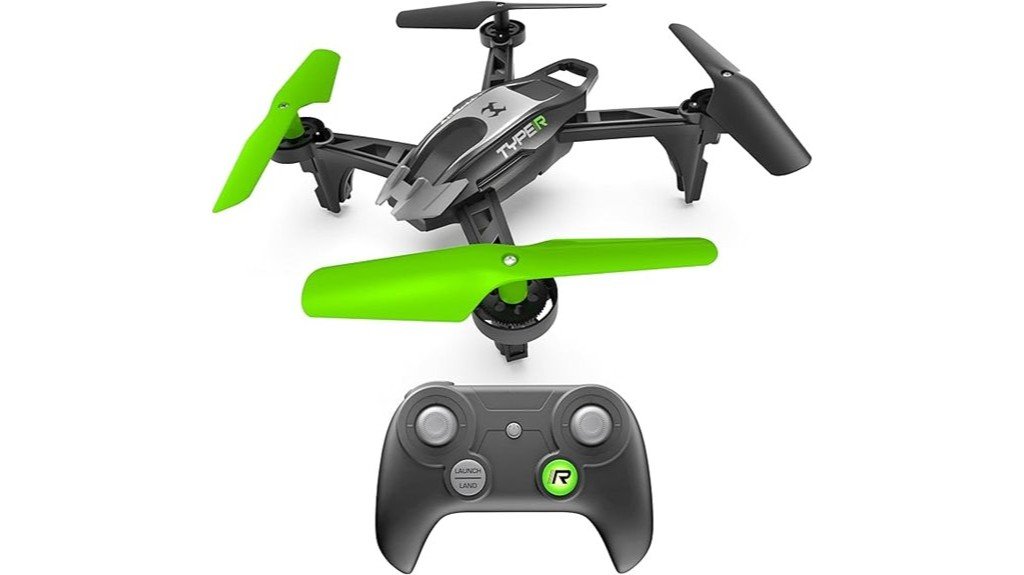
For racing enthusiasts seeking a powerful and agile drone, the Sky Viper Type-R Racing Drone stands out with its impressive top speed of over 30 mph. Weighing just 1.15 to 1.2 pounds, this compact model boasts a 2:1 power-to-weight ratio, delivering over 75% more power than its predecessors. You’ll love the sport and R modes, offering both casual and highly responsive flying experiences. With one-touch stunts and automatic launch and landing, control is effortless. The removable battery guarantees extended flight times, while the sleek white and black design adds style. Just keep an eye on customer feedback for peak performance!
Best For: Racing enthusiasts and hobbyists aged 12 and up who seek a powerful and agile drone for casual and competitive flying.
Pros:
- High Speed: Achieves top speeds over 30 mph, making it ideal for racing.
- Agility: Enhanced responsiveness in R mode allows for impressive maneuvers and stunts.
- User-Friendly Features: Includes one-touch stunts and auto launch/landing for effortless control.
Cons:
- Mixed Customer Feedback: Average rating of 3.7 stars suggests variability in performance experiences.
- Control Issues: Some users have reported difficulties with reliability and control.
- Customer Service Concerns: Mixed experiences regarding support and service from the brand.
Drone Obstacle Course Kit for RC FPV Racing Training

Designed with versatility in mind, the Drone Obstacle Course Kit is perfect for both beginners and seasoned racers looking to refine their skills. It features three hoop sizes—20, 23, and 27 inches—allowing you to progress at your own pace. You can easily create customizable routes, ranging from simple speed tracks to complex obstacle courses. Setting up takes under five minutes, and it’s portable, thanks to the included storage bags. Built with durable, weather-resistant materials, this kit withstands impacts while ensuring safety during intense races. Puzau backs it with a satisfaction guarantee, making it a solid investment for your training.
Best For: This product is best for both beginners and experienced FPV racing enthusiasts looking to enhance their skills through customizable training courses.
Pros:
- Versatile Training: Offers three hoop sizes to cater to different skill levels, promoting gradual improvement.
- Quick Setup: Assembles in under five minutes, making it convenient for quick practice sessions.
- Durable Construction: Made from weather-resistant materials that withstand impacts and fading during outdoor use.
Cons:
- Remote Control Not Included: Requires a separate remote control for operation, which can be an additional cost.
- Limited Customer Feedback: Currently has only one review, which may not provide a comprehensive view of its performance.
- Sales Rank: Relatively low sales rank in its category may indicate limited popularity or market presence.
Tiny Hawk Freestyle 2 BNF FPV Drone
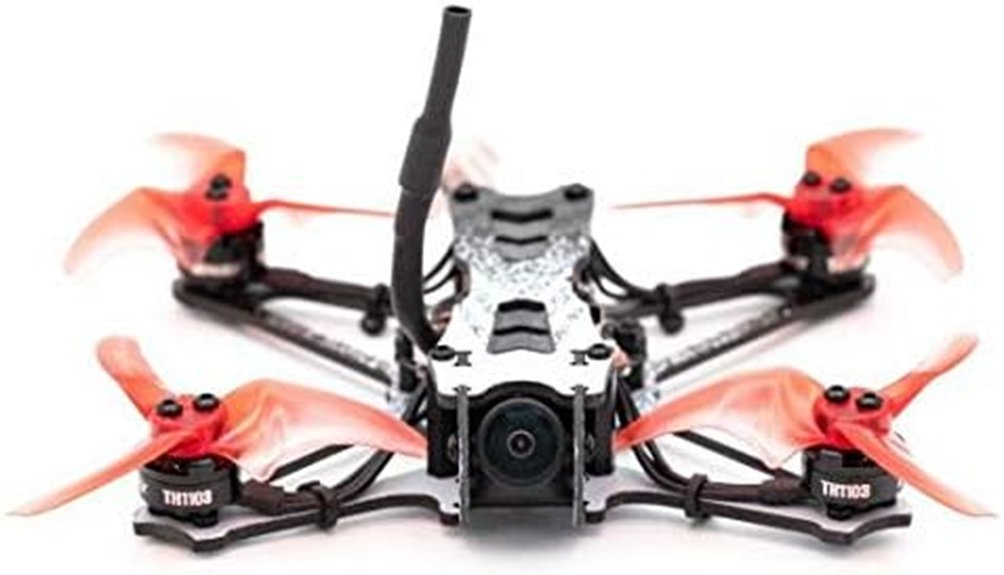
Racing enthusiasts seeking a compact and agile drone will find the Tiny Hawk Freestyle 2 BNF FPV Drone to be an excellent choice. Weighing just 8.1 ounces, its lightweight carbon fiber frame and 2.5-inch size make it perfect for tight racing environments. Enjoy crisp 720p video capture with its CMOS optical sensor, although some users note that video transmission quality could improve. With two 250mAh batteries included, you’ll have plenty of power for exciting flights. Plus, the Tiny Hawk 2’s impressive handling will elevate your racing experience. Don’t miss out on this tiny powerhouse!
Best For: Racing enthusiasts looking for a compact and agile drone suitable for tight environments.
Pros:
- Lightweight carbon fiber frame enhances maneuverability and speed.
- 720p video capture provides decent visual quality for recording flights.
- Included two 250mAh batteries offer extended flight time for thrilling racing experiences.
Cons:
- Video transmission quality may not meet the expectations of some users.
- Average customer rating of 3.6 out of 5 stars indicates mixed feedback from buyers.
- Limited operating temperature range may restrict use in colder conditions.
Factors to Consider When Choosing a Drone for Drone Racing
When you’re choosing a drone for racing, several key factors can make a big difference. You’ll want to take into account the weight and size for agility, battery life for longer races, and the specifics of the flight controller and motors for performance. Propeller design also plays an essential role in how well your drone maneuvers, so keep that in mind as you shop around.
Weight and Size
Choosing the right weight and size for your racing drone can make all the difference in your performance on the track. Lighter models typically offer quicker response times and improved maneuverability, allowing you to navigate obstacles with ease. Compact drones, around 75mm, excel in tight spaces, perfect for racing through challenging courses. However, keep in mind that lighter drones may struggle with stability in windy conditions, while heavier ones can hinder agility during high-speed maneuvers. Striking the right balance between weight and size is vital. Smaller drones shine indoors where space is limited, but their susceptibility to wind could be a downside outdoors. Consider your racing environment carefully to choose the best fit for your needs.
Battery Life
Battery life plays an essential role in your racing experience, as it directly affects how long your drone can stay airborne during competitions. Most racing drones offer flight times between 5 to 20 minutes, depending on battery capacity and weight. Lithium polymer (LiPo) batteries are the preferred choice due to their high energy density and discharge rates, giving you those quick bursts of speed. Keep in mind that higher capacity batteries, measured in milliamp-hours (mAh), can extend flight times but may also add weight, affecting maneuverability. Additionally, consider the charge time; faster charging means you’ll spend less time on the ground. Finally, check the battery’s discharge rate, as it impacts acceleration and overall performance during races.
Flight Controller Features
While you may focus on speed and agility in drone racing, the flight controller is the unsung hero that ties everything together. It integrates essential components like the electronic speed controller, receiver, and on-screen display, all of which impact your drone’s performance. Look for advanced flight controllers with built-in gyroscopes and accelerometers; these features enhance stability and responsiveness, allowing for smoother maneuvers. Controllers supporting protocols like ExpressLRS improve your control range and reduce latency, vital for competitive settings. Additionally, consider the processing speed; some models offer up to a 55% increase, enabling quicker execution of complex maneuvers. Finally, verify compatibility with motors and propellers to optimize thrust and efficiency, boosting your acceleration and overall racing performance.
Motor Specifications
The flight controller sets the foundation for your racing drone, but the motors are what truly drive its performance. When selecting motors, focus on the type and KV rating. Brushless motors are your best bet—they’re efficient, long-lasting, and provide superior thrust. A higher KV rating means faster spin rates, increasing your drone’s speed and agility.
Consider motor size, typically measured in millimeters; larger motors can generate more power, enhancing your thrust-to-weight ratio. This balance is essential for maneuverability, allowing quicker acceleration and sharper turns. Ultimately, choosing motors with a high thrust-to-weight ratio will give you an edge in competitive racing environments, ensuring you stay ahead of the pack.
Propeller Design
Choosing the right propeller design is essential for maximizing your drone’s performance in racing. The material you select—whether durable plastic or lightweight carbon fiber—affects speed and agility. Pay attention to the size and pitch; larger propellers provide more lift, while a steeper pitch can boost speed but may compromise efficiency. Most racing drones utilize two-blade propellers for quicker acceleration, though three-blade designs offer greater stability. Additionally, an aerodynamic propeller shape minimizes drag, enhancing your overall flight performance. Don’t forget that regular maintenance and timely replacement of worn-out propellers are critical for maintaining ideal performance and ensuring safety during competitive races. By carefully considering these factors, you can elevate your racing experience greatly.
Camera Quality
When it comes to drone racing, camera quality plays a vital role in your ability to navigate through challenging courses at high speeds. A higher video capture resolution, like 720p or 1080p, delivers clearer visuals, making it easier for you to spot obstacles and track paths effectively. Pay attention to the frame rate; options of 60fps or higher minimize motion blur during fast maneuvers, ensuring a smooth video feed. Low latency is essential too—delays can mislead you, complicating precise control in competitive settings. Additionally, drones with adjustable camera angles give you a better perspective of your racing environment, enhancing visibility and improving your flight strategy. Ultimately, these factors contribute greatly to your racing success.
Durability and Build Quality
While racing drones at high speeds, you need a model that can withstand the rigors of intense competition. Look for carbon fiber frames; they’re lightweight yet incredibly strong, providing excellent crash resistance. Pay attention to the build quality—reinforced weak points can enhance reliability during those nail-biting races. Opt for drones with flexible joints, as they absorb impacts better, making them ideal for obstacle courses. The overall weight is critical too; a lighter drone improves agility but must still be structurally sound. Finally, consider weather-resistant materials to extend your drone’s lifespan, protecting it from UV damage and environmental factors during outdoor races. Prioritizing durability and build quality will keep you competitive and confident on the track.
Frequently Asked Questions
What Is the Ideal Battery Life for Racing Drones?
The ideal battery life for racing drones is around 4 to 10 minutes. You’ll want enough power for intense races, but lighter batteries can enhance speed and maneuverability, making them an essential choice for competitive flying.
How Do I Improve My Drone Racing Skills?
To improve your drone racing skills, practice regularly, study your flight patterns, and analyze your performance. Join local racing groups, watch tutorials, and challenge yourself with different courses to enhance your speed and precision.
Are Racing Drones Suitable for Beginners?
Racing drones can feel a bit intimidating for beginners, but they’re not entirely off-limits. With practice and patience, you’ll find joy in mastering them, turning your initial struggles into thrilling, high-speed adventures.
What Safety Gear Should I Use While Racing Drones?
You should wear a helmet, goggles, and gloves when racing drones. Consider using knee and elbow pads for extra protection. Always verify your flying area is clear to minimize accidents and keep yourself safe.
How Can I Customize My Racing Drone for Better Performance?
To release your drone’s potential, swap in high-performance motors, upgrade the propellers, and fine-tune the flight controller. You’ll feel the thrill as your customized racer slices through the air with unmatched speed and agility.
